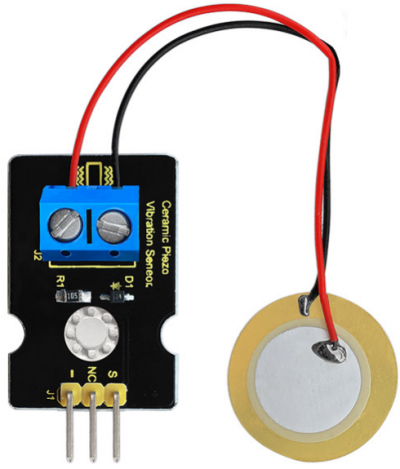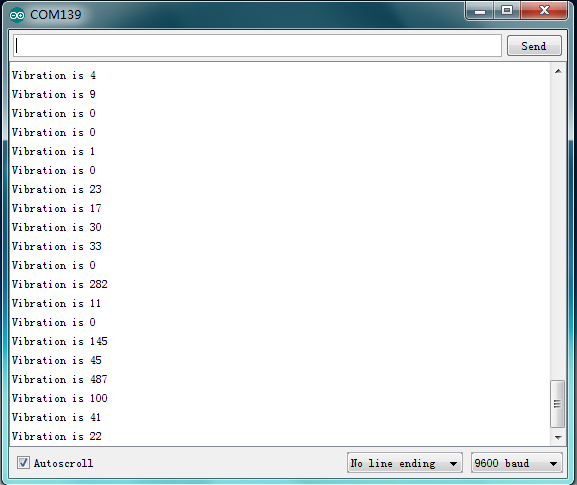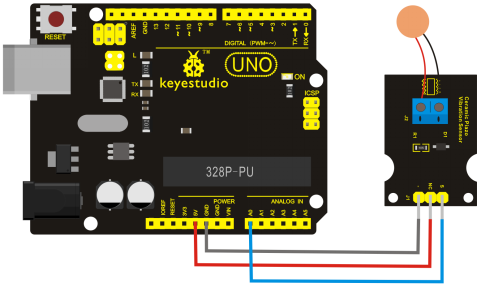Ks0272 keyestudio Analog Piezoelectric Ceramic Vibration Sensor: Difference between revisions
Keyestudio (talk | contribs) |
Keyestudio (talk | contribs) |
||
| (4 intermediate revisions by the same user not shown) | |||
| Line 1: | Line 1: | ||
<br> | |||
==Introduction== | ==Introduction== | ||
This vibration sensor is based on piezoelectric ceramic chip analog vibration. It makes use of the anti-conversion process that piezoelectric ceramic vibration will generate the electric signals. When vibrating the piezoelectric ceramic chip, the sensor’s signal terminal will generate electrical signals. <br> | This vibration sensor is based on piezoelectric ceramic chip analog vibration. It makes use of the anti-conversion process that piezoelectric ceramic vibration will generate the electric signals. <br> | ||
When vibrating the piezoelectric ceramic chip, the sensor’s signal terminal will generate electrical signals. <br> | |||
The sensor can be used with Arduino dedicated sensor shield, and Arduino analog port can perceive weak vibration signals, so that it can make interactive works related to vibration, such as electronic drum. <br> | The sensor can be used with Arduino dedicated sensor shield, and Arduino analog port can perceive weak vibration signals, so that it can make interactive works related to vibration, such as electronic drum. <br> | ||
Connect the vibration sensor to the analog port A0 of Arduino UNO. When vibrating the sensor in different degrees, you will see the different output value displayed on serial monitor. | Connect the vibration sensor to the analog port A0 of Arduino UNO. When vibrating the sensor in different degrees, you will see the different output value displayed on serial monitor.<br> | ||
<br>[[File:Ks0272-1-1.png|400px|frameless|thumb]]<br> | |||
<br> | |||
==Specification== | ==Specification== | ||
* Supply Voltage: 3.3V to 5V | * Supply Voltage: 3.3V to 5V | ||
* Working Current:<1mA | * Working Current:<1mA | ||
| Line 15: | Line 16: | ||
* Output Signal:analog signal | * Output Signal:analog signal | ||
<br> | |||
==Connection Diagram== | ==Connection Diagram== | ||
<br>[[File:Ks0272.png|700px|frameless|thumb]]<br> | |||
<br> | <br> | ||
==Sample Code== | ==Sample Code== | ||
| Line 36: | Line 38: | ||
</pre> | </pre> | ||
<br> | |||
==Result== | ==Result== | ||
Wiring as the above diagram and upload well the code, after power-on, open the serial monitor, then set the baud rate as 9600. When vibrating the ceramic chip, you will see the data as the figure shown below. | Wiring as the above diagram and upload well the code, after power-on, open the serial monitor, then set the baud rate as 9600. When vibrating the ceramic chip, you will see the data as the figure shown below.<br> | ||
<br>[[File:Ks0272-.png| | <br>[[File:Ks0272-.png|600px|frameless|thumb]]<br> | ||
<br> | |||
==Resources == | ==Resources == | ||
''' | * '''Code:''' <br> | ||
https:// | https://fs.keyestudio.com/KS0272 | ||
* '''VIDEO:''' <br> | |||
http://video.keyestudio.com/ks0272/ | |||
<br> | |||
==Buy from== | ==Buy from== | ||
*[https://www.keyestudio.com/keyestudio-analog-piezoelectric-ceramic-vibration-sensor-for-arduino-p0385-p0385.html '''Official Website'''] | |||
*[https://www.aliexpress.com/store/product/Keyestudio-Analog-Piezoelectric-Ceramic-Vibration-Sensor-for-Arduino/1452162_32822937042.html?spm=2114.12010615.8148356.1.69731974JMlKXV Shop on aliexpress ] | |||
[[Category: Sensor]] | [[Category: Sensor]] | ||
Latest revision as of 12:11, 7 January 2021
Introduction
This vibration sensor is based on piezoelectric ceramic chip analog vibration. It makes use of the anti-conversion process that piezoelectric ceramic vibration will generate the electric signals.
When vibrating the piezoelectric ceramic chip, the sensor’s signal terminal will generate electrical signals.
The sensor can be used with Arduino dedicated sensor shield, and Arduino analog port can perceive weak vibration signals, so that it can make interactive works related to vibration, such as electronic drum.
Connect the vibration sensor to the analog port A0 of Arduino UNO. When vibrating the sensor in different degrees, you will see the different output value displayed on serial monitor.

Specification
- Supply Voltage: 3.3V to 5V
- Working Current:<1mA
- Working Temperature Range:-10℃~+70℃
- Output Signal:analog signal
Connection Diagram
Sample Code
void setup()
{
Serial.begin(9600); //Open the serial to set the baud rate for 9600bps
}
void loop()
{
int val;
val=analogRead(0); //Connect the analog piezoelectric ceramic vibration sensor to analog interface 0
Serial.print("Vibration is ");
Serial.println(val,DEC);//Print the analog value read via serial port
delay(100);
}
Result
Wiring as the above diagram and upload well the code, after power-on, open the serial monitor, then set the baud rate as 9600. When vibrating the ceramic chip, you will see the data as the figure shown below.

Resources
- Code:
https://fs.keyestudio.com/KS0272
- VIDEO:
http://video.keyestudio.com/ks0272/
